Ever wonder what hides beneath the surface of North American lakes and rivers? These freshwater habitats are home to some seriously BIG fish – whoppers that might make your jaw drop! These enormous fish, which have lived in these waters for ages, will be the topic of our discussion.
We’re listing the Top 10 Biggest Freshwater Fish in North America Right Now! Not only do these amazing animals break records, but they also contribute significantly to the health of our waterways. Prepare to encounter fish that might take your breath away, sturgeon the size of tiny automobiles, and predators that look like they belong in the primordial era! Get ready to be surprised by the amazing creatures hiding in our waters
Top 10 Largest Freshwater Fish In North America
The Undisputed King: White Sturgeon

Image Source: https://www.flickr.com/photos/ecosnake/
The White Sturgeon is a true heavyweight champion, holding the title of the largest freshwater fish in North America. These gentle giants can grow to be:
- Massive: Up to 20 feet long, which is about the size of a limousine!
- Heavyweight: Weighing over 1,500 pounds, that’s more than a grand piano!
Age and Records:
The oldest documented White Sturgeon was a whopping 110 years old! The biggest one ever caught was a monster from the Columbia River in 1898, weighing an incredible 682 kilograms (almost 1,500 pounds).
Rarity and Consumption:
Sadly, White Sturgeon are considered vulnerable due to overfishing and habitat loss. While commercially fished in the past, catching them is now heavily regulated or banned in many areas.
Can You Eat Them?
While White Sturgeon are technically edible, their vulnerable status and role in the ecosystem make consumption highly discouraged.
A Prehistoric Predator: Alligator Gar

Image credit: https://www.flickr.com/photos
The Alligator Gar isn’t just big, it’s a prehistoric throwback! Here’s the scoop on this fascinating fish:
- Size: They can reach lengths of over 10 feet, about the size of a smart car!
- Weight: They can tip the scales at over 300 pounds.
- Lifespan: These living fossils can live for an estimated 50 years in the wild.
Record Breakers and Population:
The biggest Alligator Gar ever caught was a monster that weighed over 300 pounds! While not necessarily rare, their exact population numbers are unknown. Conservation efforts are underway to ensure their survival.
Diet and Danger:
Alligator Gar are apex predators with a taste for fish, reptiles, and even small mammals. However, despite their size and toothy grin, they aren’t typically dangerous to humans. They’re ambush hunters and will usually only attack if they feel threatened.
On the Plate:
While technically edible, Alligator Gar consumption is discouraged due to their conservation status. It’s better to admire these living fossils in their natural habitat!
Great Lakes Giant: Lake Sturgeon

Image credit: https://www.flickr.com/photos/joshuaraabe
The Great Lakes aren’t just home to amazing views, they’re also home to the Lake Sturgeon, a close relative of the White Sturgeon. Here’s the lowdown on this fascinating fish:
- Size: They can grow up to 8 feet long, about the length of a pool table!
- Weight: They can reach weights exceeding 200 pounds.
- Lifespan: These giants can live for over 100 years, making them one of the longest-lived freshwater fish in North America.
Record Holders and Rarity:
The biggest Lake Sturgeon ever caught was a beast weighing over 200 pounds! Sadly, due to overfishing and habitat loss, Lake Sturgeon are considered a threatened species.
Diet and Danger:
Lake Sturgeon are bottom feeders, using their vacuum-like mouths to clean up the ecosystem. They pose no danger to humans.
On the Plate:
While technically edible, Lake Sturgeon are protected due to their threatened status. It’s best to leave them in the water to continue their important role in the ecosystem.
The Mighty Catfish: Blue Catfish
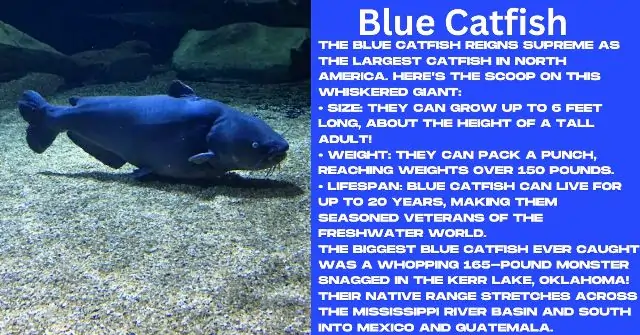
Image source: https://www.pinterest.ph/joebailey1936/
The Blue Catfish reigns supreme as the largest catfish in North America. Here’s the scoop on this whiskered giant:
- Size: They can grow up to 6 feet long, about the height of a tall adult!
- Weight: They can pack a punch, reaching weights over 150 pounds.
- Lifespan: Blue Catfish can live for up to 20 years, making them seasoned veterans of the freshwater world.
Record Breaker and Range:
The biggest Blue Catfish ever caught was a whopping 165-pound monster snagged in the Kerr Lake, Oklahoma! Their native range stretches across the Mississippi River basin and south into Mexico and Guatemala.
Population and Consumption:
Blue Catfish are not considered rare, but their populations can vary depending on the specific habitat. They are a popular sport fish, but due to their size and potential impact on native ecosystems, regulations on catching and consuming them can vary by location. Always check local fishing regulations before heading out.
Danger:
While Blue Catfish have sharp spines in their fins, they aren’t dangerous to humans unless provoked. Handle them with care if you catch one and plan to release it.
The Flathead Catfish: Master of Ambush

Image source: https://www.pinterest.ph/liv2bowhunt/
The Flathead Catfish lives up to its name with a broad, flattened head perfect for lurking unseen. Here’s the info on this fascinating predator:
- Size: They can reach up to 4 feet long, about the length of a yoga mat!
- Weight: Flathead Catfish can tip the scales at over 100 pounds.
- Lifespan: These ambush experts can live for an estimated 20 years.
Record Breaker and Population:
The biggest Flathead Catfish ever caught was a behemoth weighing over 123 pounds! While not necessarily rare, their exact population numbers are unknown.
Diet and Danger:
Flathead Catfish are ambush predators that use their camouflage and flat head to surprise fish, reptiles, and even small mammals. Despite their impressive size, they aren’t dangerous to humans and will usually only attack if they feel threatened.
On the Plate:
Flathead Catfish are popular among anglers for their fighting spirit and delicious taste. However, regulations on catching and consuming them can vary depending on location. Always check local fishing regulations before heading out.
A Common Favorite: Channel Catfish
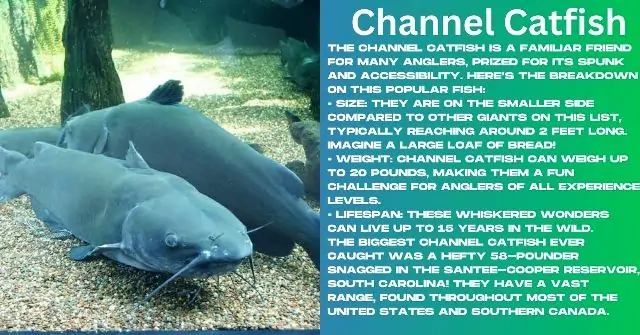
The Channel Catfish is a familiar friend for many anglers, prized for its spunk and accessibility. Here’s the breakdown on this popular fish:
- Size: They are on the smaller side compared to other giants on this list, typically reaching around 2 feet long. Imagine a large loaf of bread!
- Weight: Channel Catfish can weigh up to 20 pounds, making them a fun challenge for anglers of all experience levels.
- Lifespan: These whiskered wonders can live up to 15 years in the wild.
Record Breaker and Range:
The biggest Channel Catfish ever caught was a hefty 58-pounder snagged in the Santee-Cooper Reservoir, South Carolina! They have a vast range, found throughout most of the United States and southern Canada.
Population and Consumption:
Channel Catfish are not considered rare. Their widespread presence makes them a popular target for fishing. They are also a delicious freshwater fish, but regulations on catching and consuming them can vary by location. Always check local fishing regulations before heading out.
Danger:
Channel Catfish have sharp spines in their fins, but they aren’t dangerous to humans unless provoked. Handle them with care if you catch one and plan to release it.
Atlantic Beauty: Atlantic Sturgeon
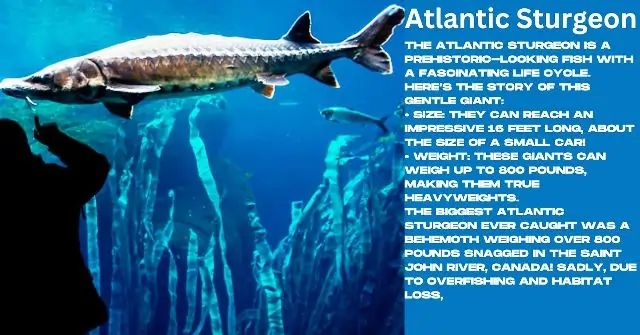
Image credit:flickr.com/photos/gregemery
The Atlantic Sturgeon is a prehistoric-looking fish with a fascinating life cycle. Here’s the story of this gentle giant:
- Size: They can reach an impressive 16 feet long, about the size of a small car!
- Weight: These giants can weigh up to 800 pounds, making them true heavyweights.
Record Breaker and Status:
The biggest Atlantic Sturgeon ever caught was a behemoth weighing over 800 pounds snagged in the Saint John River, Canada! Sadly, due to overfishing and habitat loss, Atlantic Sturgeon are listed as threatened or endangered depending on the specific population.
Diet and Lifespan:
Atlantic Sturgeon are omnivores, feeding on worms, clams, and other bottom dwellers throughout their long lives. They can live for up to 100 years, making them one of the longest-lived fish species in North America.
Rarest and Consumption:
Atlantic Sturgeon populations are considered rare or endangered in many areas. Catching and consuming them is heavily regulated or banned in most locations to aid in their recovery.
Danger:
Atlantic Sturgeon are not dangerous to humans. They are peaceful bottom feeders and pose no threat.
The Fierce Predator: Muskellunge

Image credit:flickr.com/photos/mddnrfish
The Muskellunge, often nicknamed “Musky” by anglers, is a true freshwater force to be reckoned with. Here’s the lowdown on this powerful fish:
- Size: A true giant, Muskellunge can reach over 5 feet in length, imagine a tall person!
- Weight: They can pack a serious punch, tipping the scales at over 60 pounds.
Record Breaker and Population:
The biggest Muskellunge ever recorded was a whopping 69 pounds and 15 ounces, snagged in Lake Winnebago, Wisconsin! While not completely rare, Muskellunge populations vary depending on their habitat and are considered vulnerable in some areas. Conservation efforts are important to ensure their survival.
Diet and Lifespan:
Muskellunge are apex predators, using their sharp teeth and powerful bodies to hunt smaller fish, waterfowl, and even muskrats! They can live for an estimated 20 years.
On the Plate and Danger:
Regulations on catching and consuming Muskellunge vary by location. Due to their vulnerable status in some areas, catch and release is often the preferred practice.
Not So Dangerous:
Despite their fierce appearance, Muskellunge are not a danger to humans. They are ambush hunters and will usually only attack if they feel threatened.
Coldwater Gem: Lake Trout
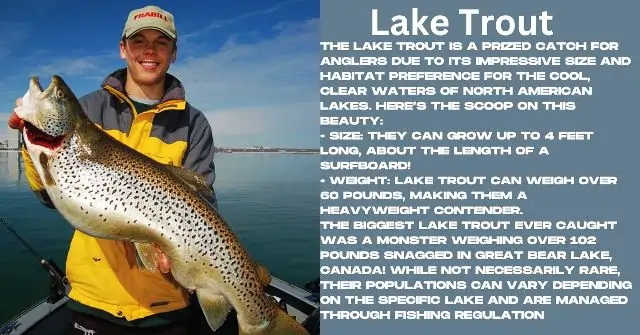
image credit:in-fisherman.com/editorial
The Lake Trout is a prized catch for anglers due to its impressive size and habitat preference for the cool, clear waters of North American lakes. Here’s the scoop on this beauty:
- Size: They can grow up to 4 feet long, about the length of a surfboard!
- Weight: Lake Trout can weigh over 60 pounds, making them a heavyweight contender.
Record Breaker and Population:
The biggest Lake Trout ever caught was a monster weighing over 102 pounds snagged in Great Bear Lake, Canada! While not necessarily rare, their populations can vary depending on the specific lake and are managed through fishing regulations.
Diet and Lifespan:
Lake Trout are opportunistic feeders, adapting their diet to what’s available. They enjoy a menu of smaller fish, insects, and even crustaceans. They can live for up to 30 years, making them a long-lived resident of the deep.
Consumption and Danger:
Lake Trout are a delicious freshwater fish, but regulations on catching and consuming them vary by location due to population management practices. Always check local fishing regulations before heading out.
Not a Threat:
Lake Trout are not dangerous to humans. They are adapted to the cold depths and pose no threat to swimmers or divers.
A Coastal Delight: Striped Bass
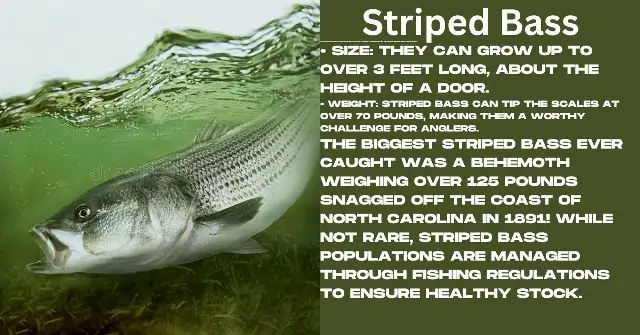
image credit:dreamstime.com/striped-bass
The Striped Bass is a popular catch along the Atlantic Coast, prized for its impressive size and thrilling fight. Here’s the info on this exciting fish:
- Size: They can grow up to over 3 feet long, about the height of a door.
- Weight: Striped Bass can tip the scales at over 70 pounds, making them a worthy challenge for anglers.
Record Breaker and Population:
The biggest Striped Bass ever caught was a behemoth weighing over 125 pounds snagged off the coast of North Carolina in 1891! While not rare, Striped Bass populations are managed through fishing regulations to ensure healthy stock.
Diet and Lifespan:
Striped Bass are anadromous, meaning they migrate between freshwater and saltwater throughout their lives. Their diet is varied, consisting of smaller fish, shrimp, and other marine creatures. They can live up to 30 years.
On the Plate and Danger:
Striped Bass are a delicious saltwater fish, but regulations on catching and consuming them vary by location. Always check local fishing regulations before heading out.
Not So Feisty:
Striped Bass are not dangerous to humans. While they may put up a fight when hooked, they are not aggressive and pose no threat to swimmers or divers.
What is the king of fish in the world?
The “King of Fish” title commonly refers to the Atlantic Salmon, celebrated for its impressive life cycle and culinary appeal. These fish go on an incredible trip from where they’re born in fresh water to the ocean, and then they come back to have babies, showing great strength and skill. People love them in restaurants and at home because they taste really good and have a nice feel, making them a special food.
Additionally, Atlantic Salmon are a prized catch among anglers due to their size and the challenge they present. This unique combination of traits—from their migratory habits to their status in the culinary and sportfishing worlds—solidifies their royal standing.
FAQ on ” Top 10 Largest Freshwater Fish In North America”
Q: What’s the undisputed king of North American freshwater fish?
A: The White Sturgeon reigns supreme, reaching a whopping 20 feet long and over 1,500 pounds!
Q: Are any of these giants prehistoric-looking?
A: Absolutely! The Alligator Gar resembles an ancient predator with its long snout and rows of sharp teeth.
Q: Where can I find the Great Lakes Giant, the Lake Sturgeon?
A: Look for these impressive fish in the Great Lakes and various eastern rivers of North America.
Q: What’s the most popular catfish on this list for sport anglers?
A: The Channel Catfish takes the crown for popularity due to its widespread presence and fighting spirit.
Conclusion– Top 10 Largest Freshwater Fish In North America
These amazing creatures are abundant in the freshwater environments of North America, and each one has distinct traits and functions within the ecosystem. These fish, which range from Long-faced catfish to ancient carnivores, are living examples of the wonders of the natural world.
Remembering that these amazing animals depend on us for survival is crucial. The key to guaranteeing their survival for future generations is conservation work and ethical fishing methods.
Were you surprised by any of these giants? Perhaps you’ve even personally encountered a whopper! We’d love to hear from you, so please share your questions and stories in the comments section below!
Hooked on Conservation?
These magnificent fish are a vital part of healthy freshwater ecosystems, and it’s our responsibility to ensure their survival for generations to come. Here are some ways you can help:
- Fish Responsibly: Always check and follow fishing regulations in your area. These regulations are put in place to ensure healthy fish populations.
- Respectful Release: If you catch one of these giants and plan to release it, handle it with care and wet your hands before touching it to protect its slime coat.
- Consider Catch and Release: For some of these threatened species, catch and release fishing is the best practice.
- Support Conservation Efforts: Organizations like the American Fisheries Society (AFS) and The Nature Conservancy are dedicated to freshwater fish conservation. Consider volunteering or donating to support their important work.
Tips for Catching Some of These Giants:
- Do Your Research: Different fish species require different techniques and bait. Research the specific fish you’re targeting to improve your chances of success.
- Find the Right Spot: Consider the habitat preferences of each fish species. Look for areas with the right kind of structure and water depth.
- Use Appropriate Gear: Choose your rod, reel, and line based on the size and strength of the fish you’re targeting.
- Practice Patience: Fishing for these giants can be challenging. Be patient, persistent, and enjoy the experience!
Remember, responsible fishing practices and an appreciation for these incredible creatures go hand-in-hand. Let’s work together to ensure these North American giants continue to grace our freshwater ecosystems for years to come!
